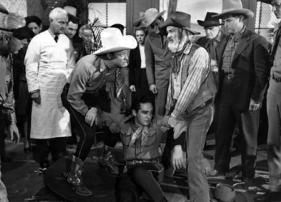Directed by Frank McDonald
Republic Pictures Corp. Producer: Edward J. White. Screenwriter: Max Brand, Gerald Geraghty. Cinematography: Reggie Lanning. Editor: Les Orlebeck. With: Roy Rogers, George Gabby Hayes, Dale Evans, Sheldon Leonard, Robert Emmett Keane.35mm, b/w, Sound, 65 min.
Like Gene Autry, Roy Rogers worked for Republic, cranking out westerns for the Saturday matinee crowd. Like Gene, Roy was a singing cowboy, not a tough guy like Harry Carey or Bob Steele. Rainbow Over Texas was Rogers’ 60th film since 1935, counting uncredited roles and the 27 films in which he played a film version of himself. Then there was Trigger, his faithful horse, and Dale Evans, who had already been his steady squeeze for 15 films, and would partner with him on at least as many again, marry Roy, and star in a tv show that ran for six years from 1951-57. Then there was the sidekick, Gabby Hayes, who likewise starred in at least twelve films with Rogers, having previously served as William Boyd alias Hoppalong Cassidy’s sidekick. However, Rainbow was not just routine. Dale Evans, for example, does a little cross dressing, appearing first as a boy to travel West. Roy is returning to his hometown when he meets her and falls in love.
Jan-Christopher Horak
Preserved in cooperation with Paramount Pictures from a 35mm nitrate composite fine grain master positive and an acetate composite reissue print. Laboratory services by The Stanford Theatre Film Laboratory, Audio Mechanics, DJ Audio.






 Mobile Navigation
Mobile Navigation



